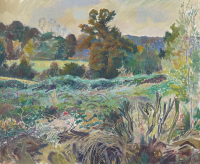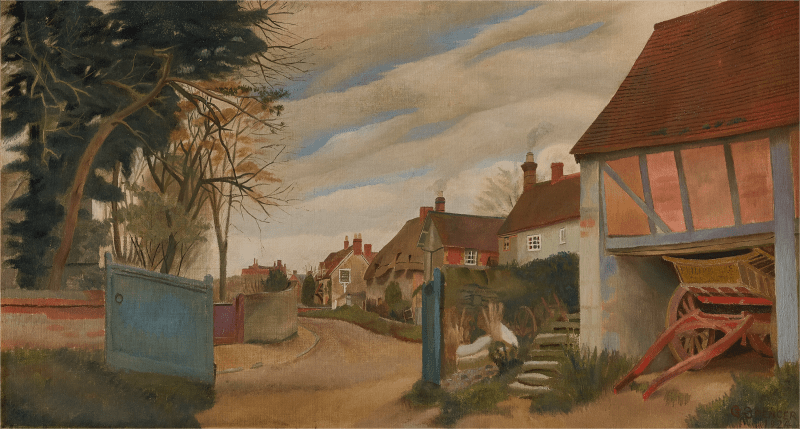This landscape by British artist, Gilbert Spencer, echoes a significant post-War sensibility towards an increasing return to nature as a source of spiritual clarity and strength.[1] Unlike the traditionally popular settings of landscaped gardens or cultivated woodland, Spencer’s untamed and naturalistic wooded landscape celebrates the disobedient overgrowth of rural England.
A close observer of rural life, Spencer was known to spend hours admiring the rural landscape in which he frequently immersed himself. Art Historian, Duncan Robinson, notes the ‘familiar themes of retreat into the landscape and communion with nature’ which were becoming increasingly prolific within the British arts and particularly resonated with Spencer himself.[2] This painting is thought to depict the rural countryside of Oxfordshire, where Spencer spent much of his time painting. The grass and branches foregrounded in Spencer’s characteristic bold lines allude to the careful implementation of contrasting colours and textures which are also found in the work of his older brother, Stanley Spencer. Spencer’s capacity to...
This landscape by British artist, Gilbert Spencer, echoes a significant post-War sensibility towards an increasing return to nature as a source of spiritual clarity and strength.[1] Unlike the traditionally popular settings of landscaped gardens or cultivated woodland, Spencer’s untamed and naturalistic wooded landscape celebrates the disobedient overgrowth of rural England.
A close observer of rural life, Spencer was known to spend hours admiring the rural landscape in which he frequently immersed himself. Art Historian, Duncan Robinson, notes the ‘familiar themes of retreat into the landscape and communion with nature’ which were becoming increasingly prolific within the British arts and particularly resonated with Spencer himself.[2] This painting is thought to depict the rural countryside of Oxfordshire, where Spencer spent much of his time painting. The grass and branches foregrounded in Spencer’s characteristic bold lines allude to the careful implementation of contrasting colours and textures which are also found in the work of his older brother, Stanley Spencer. Spencer’s capacity to create a balanced arrangement with wild, unmanicured vegetation demonstrates his superb skills in composition and linear control. Through the calm contemplation of his brush, Spencer transforms the ordinary into the extraordinary.
In 1950, around the time that this landscape was painted, Spencer was elected an associate of the Royal Academy and a Royal Academician in 1959. Spencer’s work is now held in several public collections including the Tate, Victoria and Albert Museum, Imperial War Museum, Manchester City Galleries, Graves Art Gallery and Belfast City Art Gallery.
[1] D. Robinson, (1994) Stanley Spencer. London: Phaidon Press, p.49.
[2] D. Robinson, (1994) Stanley Spencer. London: Phaidon Press, p.49.







